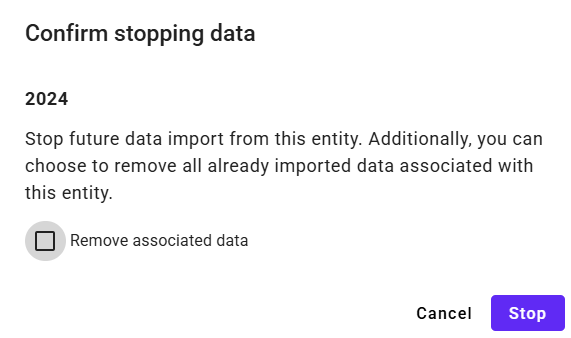Choosing Reporting Years
Selecting the reporting years is a straightforward but essential step in setting up your CO2e emissions calculations with BeWo. This guide explains how to choose reporting years, what information is displayed, and important considerations when removing years.
Why Choose Reporting Years?
The reporting years determine the time period for which you want to collect and analyze data. These years are typically aligned with your financial reporting periods, ensuring consistency between your financial and carbon accounting.
By selecting specific reporting years, you can:
- Focus Analysis: Concentrate on the periods relevant to your sustainability goals.
- Compare Performance Over Time: Track emissions trends across multiple years.
- Meet Regulatory Requirements: Comply with reporting obligations for specific fiscal years.
How to Choose Reporting Years
Choosing reporting years in BeWo is simple and involves just one action:
-
Select Reporting Years: From the list of available years pulled from your ERP system, simply check the boxes next to the years you wish to include in your emissions reporting.
-
Historic Reporting Years: Reporting years, which are prior to current reporting year might require additional one-time payment to import data. You can purchase additional historic data in Billing settings. Purchased historic years apply to all integrations. The price for each reporting year may vary, depending on your billing plan.

In this image, you can see a list of reporting years available for selection.
Understanding the Reporting Year View
In the reporting year view, you can see:
- Number of Vouchers Found: For each selected year, BeWo displays the total number of vouchers found.
What Is a Voucher?
A voucher represents a financial document or transaction recorded in your ERP system. It can include:
- Invoices
- Receipts
- Expense Reports
- Credit Notes
Each voucher may contain one or more lines of data relevant to CO2e calculations, such as:
- Expense Details
- Purchase Items
- Quantities and Prices
Understanding vouchers is important because the number of vouchers indicates the volume of data that will be processed for emissions calculations.
Note: A more detailed explanation of vouchers is available in the Core Concepts article.
Relationship Between Accounts and Vouchers
The number of vouchers in a reporting year is influenced by the financial accounts you have selected:
- More Accounts Selected: Including more financial accounts will generally lead to more vouchers being processed in a reporting year, resulting in a more comprehensive emissions calculation.
- Fewer Accounts Selected: Selecting fewer accounts will limit the number of vouchers, potentially omitting relevant data from your emissions reporting.
Important Considerations When Removing Reporting Years
What Happens When You Remove a Reporting Year?
When you remove a reporting year from your selection:
-
Stopping data import form reporting year: You can stop data import from selected year by unchecking the box and saving changes. Additionally, you will be asked if you want to delete all associated data for that year.

-
Data Deletion: All associated data for that year will be deleted from BeWo.
-
Historical Data Impact: Emissions data and calculations for the removed year will no longer be available.
-
Reports and Analyses: Any reports that include the removed year will need to be updated or may be incomplete.
Removing a reporting year will permanently delete all associated data from BeWo, affecting your historical emissions records. This action cannot be undone.
Best Practices
- Review Before Removing: Carefully consider the implications before removing a reporting year.
- Backup Data: If necessary, export reports or data summaries before making changes.
- Consult Stakeholders: Discuss with your finance and sustainability teams to ensure alignment.
- Update Reports: Be prepared to update any reports or analyses that may be affected by the data deletion.
Next Steps
After selecting the appropriate reporting years, you can proceed to:
👉 Continue to: Data Pipeline
Need Help?
If you have questions or need assistance in selecting reporting years, our support team is here to help.
👉 Contact Support: Support Page
By carefully selecting the relevant reporting years and understanding the implications of removing them, you ensure that your CO2e emissions calculations are accurate and aligned with your financial reporting periods, enabling more effective sustainability management with BeWo.